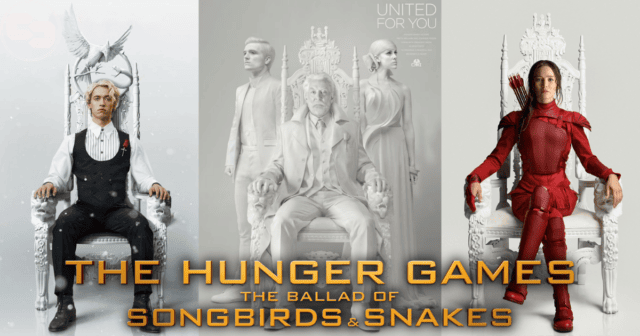Book Review: ‘The Ballad of Songbirds and Snakes’ by Suzanne Collins

Sent to die in the Hunger Games after her boyfriend’s wandering eyes land on the mayor’s daughter, Lucy Gray Baird arrives in a war-torn Capitol still rebuilding itself after the rebellion of the Dark Days. There, she meets 18-year-old Coriolanus Snow – the last hope of an elite Capitol lineage, now fallen into poverty and desperate to win a university scholarship by mentoring his tribute to victory in the Games.
Readers know that Coriolanus will one day become the ruthless President of Panem, but The Ballad of Songbirds and Snakes doesn’t focus on his rise to power. Instead, this prequel tells the story of one formative summer in Coriolanus’ life – a summer that crystalizes his understanding of humanity and the fragility with which society is held together.
[Warning: Spoilers for The Ballad of Songbirds and Snakes novel and possibly for the upcoming film ahead!]
The plot of Songbirds and Snakes
Separated into three distinct parts, with identical formatting to the original Hunger Games novels, The Ballad of Songbirds and Snakes takes readers on a journey through the damaged Capitol, into a rubble-filled arena, and finally out into the woods of District 12.
On the cusp of graduating from the Capitol’s prestigious Academy, Coriolanus only needs to ace his final assignment to secure a generous scholarship to university. Unable to afford food, and with his cousin Tigris making a pittance as a fashion designer’s assistant, this is the Snow family’s last chance to regain their pre-war wealth and influence. With the 10th Annual Hunger Games approaching, that final assignment is for top students to mentor this year’s tributes.
The Games are dying out, with no one in the districts watching and Capitol citizens tired of the brutality of children hacking each other to death with rusty weapons in a dilapidated sports arena. The Hunger Games needs a makeover, something fresh to re-interest audiences. That refresh comes in the form of these student mentors, pre-show interviews, and the event’s first-ever host. Coriolanus’s contentious relationship with Dean Highbottom, creator of the Games, leaves him with the worst possible tribute: the girl from District 12.
Luckily, Lucy Gray Baird is a born performer, the antithesis of Katniss Everdeen, and she quickly becomes a Capitol favorite after her theatrics at the reaping. Deceptively cunning, Lucy Gray has a heart of gold but knows how to survive. We all know Coriolanus can play people like a fiddle, but he’s met his match in Lucy Gray.
This unlikely pair become a united front, both doing whatever it takes to survive until they find something deeper in each other. Entering the arena is only the first step, because the real world may be just as dangerous. However, you never quite know whether Coriolanus and Lucy Gray’s feelings for each other are real or not, a concern that comes to a dramatic head in the heart-pounding, emotionally-charged climax.

In fact, several moments in the novel take on an unbelievable quality. Chapters end with shocking cliffhangers that further expose how rough the production of the Hunger Games used to be. By the time the victor is crowned, it’s clear that the 10th Hunger Games have introduced successful new twists but were an egregious disaster in equal measure.
Characters and connections to the original Hunger Games
Coriolanus may be the protagonist of this novel, but he is certainly no hero. While the book does create sympathy for Snow, it’s also very careful to never excuse or justify his terrible actions. The Ballad of Songbirds and Snakes plays more like a tragedy where you can see the push and pull of the positive and negative influences on Coriolanus’s life.
He has many opportunities to do the right thing, to step off the path he’s heading down, supported by characters like Tigris, Lucy Gray, and Sejanus Plinth. However, Coriolanus also must contend with the influence of characters like Dr. Volumnia Gaul, whose twisted ambitions eerily reflect within himself.
Sejanus Plinth, a boy from District 2 whose family bought their way into the Capitol with newfound wealth in the aftermath of the rebellion, is the opposite of Coriolanus. A good person to a fault, Sejanus is horrified at the concept of the Hunger Games and wants to help everyone in the districts. As one of his only friends, Coriolanus must save Sejanus from himself but risks damaging his own reputation the closer he gets to a district sympathizer.
Tigris Snow and the cousins’ grandmother are key supporting characters but don’t get much of a story themselves. Other Academy students come and go, but Dr. Volumnia Gaul stands out as a truly unhinged Head Gamemaker. Her unpredictable nature and creepy muttations make her a terrifying mad scientist who delights in harming others. On the other hand, Dean Highbottom could care less about the Games and is more concerned about where his next morphling fix is coming from.
Lucy Gray and her band of Covey, a kind of found family, are the opposite of prim and polished Capitol citizens in every way. Breezy and kind, Lucy Gray wins peoples’ hearts by simply being herself. She works the audience effortlessly, both in the Capitol and her home of District 12. The Covey’s strong family bond and enjoyment of the simple pleasures in nature signify the divide between Capitol and district life like never before.
Familiar Hunger Games themes in this prequel novel
Of course, the Covey are where connections to the original novels are subtly revealed. As implied by the title, The Ballad of Songbirds and Snakes features a lot of singing. Most of these songs are brand-new folk numbers unique to District 12, but some of them will be very familiar to Hunger Games fans. This includes one we were all expecting to hear again.
But this is where Songbirds and Snakes truly excels. No one in this story is revealed to be Katniss’s grandmother or relative, but subtle parallels to her story 64 years later add even more layers to the complexity of the original novels. Some of these parallels contain major spoilers, so I’ll be examining them in a separate article soon. Suffice it to say, that song you were waiting for does appear in this novel. However, the context of its performance adds a hidden meaning no one could have seen coming, one that Katniss could never be aware of, but the reader can revel in.
The Ballad of Songbirds and Snakes is only a snapshot of a few months in Coriolanus Snow’s life, but that is what makes the story so interesting. He does not start out as the dictator the districts hate by Katniss’s time, but those traits have irreparably set in by the epilogue as a result of his experiences in the 10th Hunger Games and the fallout afterwards. Told from a Capitol perspective, the themes of this novel parallel but differ from the themes of the originals.
The Hunger Games themselves take on an impersonal feeling as we readers watch them through a screen with Capitol students rather than living the battles with the tributes. While this novel also touches on the origin and effects of war, struggle for survival, class division, and the ethics of the Games, these topics are bent through a different lens.
No longer is everyone in the Capitol rich while everyone in the districts is poor. Coriolanus Snow is as poor as any starving district child due to the destruction of his family’s weaponry fortune in District 13, while transplants from 2 waltz their way into the Capitol thanks to the subsequent munitions boom caused by 13’s annihilation. The ethics of entertainment are debated in a different manner because the Games are not truly entertaining yet. They’re more execution than entertainment, making them much more painful to watch for every citizen of Panem.
What stands out the most is the novel’s commentary on human nature and the need for control. Coriolanus is familiar with desperation, but doesn’t understand the true nature of humanity until Dr. Gaul pushes him into terrible situations he cannot escape from. These crucibles forge Coriolanus into the dictator he will become. While it’s impossible to sympathize with his twisted thinking, the reader clearly sees how his morals adjust under pressure and how he justifies his own actions in an endless cycle of overthinking and selfish reasoning.
Should you read The Ballad of Songbirds and Snakes by Suzanne Collins?
The Ballad of Songbirds and Snakes is an excellent prequel that does not rely on nostalgia and cheap fan service. Instead, it tells a story fans did not ask for but one that expands the world of Panem and the themes Suzanne Collins aims to explore. This is definitely not the kind of prequel you want to read before the originals. Every reference to the original novels adds layers to the complex hero vs. villain relationship at the center of the Hunger Games trilogy, adding further meaning to Katniss and Snow’s interactions.
While the book does have minor issues, such as being awkwardly paced, its ending and the web of emotions it leaves you with are enough to trump the problems. This is a book that will live in your mind for days or weeks, particularly thanks to Collins’ habit of leaving some things unsaid and up to the reader’s imagination. You won’t get every answer here, but you’ll see enough of Coriolanus Snow and Lucy Gray Baird’s lives to understand why 64 years later, Snow is a controlling dictator.
My Rating: 10/10
The Ballad of Songbird and Snakes by Suzanne Collins is currently available on Amazon and most places books are sold. Are you going to read the book before seeing the film adaptation that’s releasing on November 17th? Let us know on social media @mycosmiccircus or in The Cosmic Circus Discord.
Review: The Hunger Games: The Ballad of Songbirds and Snakes Deepens the World of Panem
Coriolanus Snow’s Journey in Songbirds and Snakes Reframes Original Hunger Games
The Hunger Games: The Ballad of Songbirds and Snakes Trailer Breakdown!





